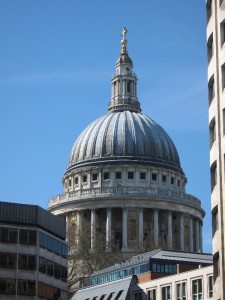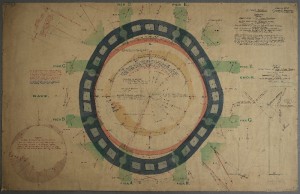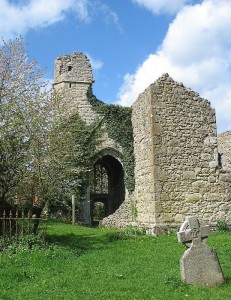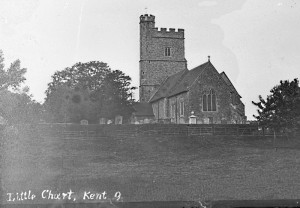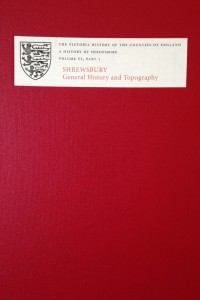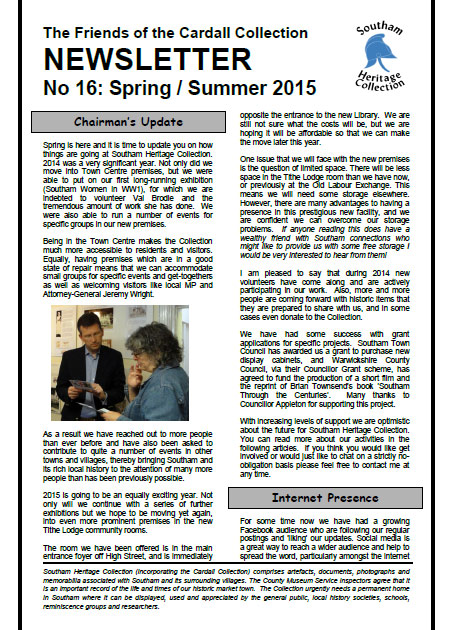Meeting Report 17th April 2015
At the Group’s April meeting an attentive audience in Kineton Village Hall heard an illustrated talk by Chris Rice, who described the major landscape project he is leading at Compton Verney.
He explained how the original medieval and Tudor manor house with a mill pond and water mill was remodelled in 1711, and then enlarged by Robert Adam in the most up-to-date style in the1760s. At the same time the unfashionable formal avenues of the earlier park were swept away by the more naturalistic landscaping of Capability Brown. Chris Rice used historic maps and plans to demonstrate the dramatic changes Adam and Brown accomplished. The Brownian landscape experience involved buildings as well as well as trees, lakes and grass, and Chris drew our attention to a ruined structure clearly visible from the Kineton to Wellesbourne road which many of us have driven past but not noticed. Other buildings such as the Orangery have disappeared altogether, although the Ha Ha – an essential element of every 18th century park – still survives, albeit in need of some repair. The Icehouse has already been restored.
After the estate was sold by the Verneys in 1922 the house and park deteriorated. In 1993 the Peter Moores Foundation acquired the estate and rescued the derelict house, establishing the flourishing art gallery, and beginning to restore the important historic Capability Brown landscape. The current multi-million pound project, partly funded by the Heritage Lottery Fund, aims to continue the restoration of the landscape. Chris showed some of the past indignities suffered by the historic landscape, including the demolition of the parapet of the elegant 18th century bridge by a wayward jeep during the occupation of the estate by the army during WWII, and the use of the Sphinges on the bridge for target practice in the same period. We heard how Capability Brown himself removed Combrook parish church because it obstructed the view of his improved lake. He moved the important Verney monuments to his new chapel, itself currently undergoing extensive restoration. Chris outlined the project’s aim of recreating some of Brown’s footpaths to make the landscape more accessible, using early documents and archaeological research to discover their original locations and materials. Negotiating the 21st century planning and regulatory pitfalls seems to be a major element of his brief!
We were left in no doubt that when completed the project will greatly enhance our experience of the Compton Verney house and landscape, but the insights Chris Rice gave his Kineton audience will already enrich their next trip to the house and its grounds. Roger Gaunt gave a vote of thanks on behalf of the meeting and discussions continued over tea, coffee and biscuits.
Elizabeth Allison will give us an illustrated talk entitled “Follies: a look at some eccentric buildings” at our next meeting on Friday 15th May at Kineton Village Hall at 7.30pm. Visitors are welcome, the £2.00 at the door includes refreshments after the talk.
DF 26.04.2015
Author Archives
Report April 2008
PRESS RELEASE 14.04.08
KINETON AND DISTRICT LOCAL HISTORY GROUP NEWS
Bring Out Your Bygones Day
On Saturday 12th April the Kineton & District Local History Group hosted “Bring Out Your Bygones” in Kineton Village Hall. Maggie Wood and Jon Radley from Warwickshire Museum, and Angie Bolton from the Portable Antiquities Scheme, specializing in domestic, geological and archaeological objects were on hand to identify and discuss the bygones. The people of Kineton and district brought along about 100 objects to find out more about them and their historical significance.
Angie Bolton identified a fine prehistoric flint arrowhead brought in from Wellesbourne by Bill Chedham, and reviewed considerable collections of Roman and later material collected from fields around Tysoe and Kineton by Kevin Wyles and David Beaumont. Charles De’Ath brought in a mixed collection of geological and archaeological material. This included a fine Iron Age pot and Roman sherds. Maggie Wood identified a fine 19th century lace pillow cover, a christening gown dated to 1880, a wooden flour container, as well as a bewildering variety of historic and exotic material. Jon Radley recognised a fine 200 million year old Jurassic fish (ichthyosaurus) backbone the size of a saucer from Kineton brought in by Bob Crockett, and a trilobite in the Charles De’Ath collection.
The more exotic objects brought in included two pen-and-ink holders used by middle eastern scribes, a WWI German Iron Cross complete with ribbon, a chatelaine for keys and a perfume flask probably from the Balkans, a couple of elegant pre-war cigarette holders, and a stone with WWII graffiti from German POWs held at Ettington Camp. These reveal the links between Kineton people and wider historic events, as soldiers and travellers returned to the village bringing souvenirs.
Some objects would repay further study, such as some of the paintings, and the experts referred the owners to sources of specialist information. The purpose of some other objects beat the experts and remained mysteries, such as this wooden, 60 centimetre long, slotted paddle-like implement. Do you know what it is for? [PICTURE ATTACHED].
The day was a great success, as the people of Kineton discovered what their bygones were, and the experts filled in a little more of the history of the village.
This was the second event of the Group’s 21st Anniversary Year, and the next will be the Kineton Snapshot in June and July.
For further information please contact
David Freke 07876 290044 or email frekedj@globalnet.co.uk
Angie Bolton on 01905 721130 or abolton@worcester.gov.uk
Maggie Wood on 01926 412021 or maggiewood@warwickshire.gov.uk
Jon Radley on 01926 418182 or jonradley@warwickshire.gov.uk
BALH e-Newsletter July 2014

St Mary the Virgin and the Holy Rood, Little Chart, Kent.
A picturesque ruin today – see Death & Destruction below.
Welcome to the June e-Newsletter from BALHI hope you have been enjoyI hope you have been enjoying the few hot summer days we’ve been having, and have managed to get out and about and undertake some history research in the sunshine. At this time of year, as the above photo shows, everything looks particularly picturesque.In this issue of the newsletter Jane Insley gives us an insight into her work at St Paul’s Cathedral; Jan Shepherd tells us about Church Recorders; Paul Tritton writes about Death & Destruction 70 years ago in Kent’s ‘bomb alley’; and Alan Crosby, the editor of The Local Historian, has some thoughts to share with you about the magazine. We also have Society News from Cornwall and Hertfordshire, and information on conferences and courses we think may be of interest. We invite you to write for the newsletter. We welcome news or comments, and would like to hear about your research. We would prefer items to be between 500 and 1000 words long, and if possible accompanied by up to three photos. The newsletter is sent out in-between delivery of TLH and LHN, but copy can be sent in at any time to the email address below. We look forward to hearing from you .. reading about other members research can enthuse and encourage. From time to time you may receive emails from us with details of an event that we are involved with in your locality. We may be asking for help, asking for support, or we may be passing on information of gatherings we think may be of interest. Please be assured that you will only receive communications from BALH, and your details will not be passed onto third parties. We hope you enjoy this issue of the BALH e-Newsletter. Jacquie Fillmore |
CONTENTS
Articles: Surveying the ‘Fabrick’ The 40th Milestone Death & Destruction The Local Historian Society News: Cornwall News Herts at War BALH Events & Visits: September Visits Local History Day Conferences: Essex through the Ages Festival of Archaeology Courses: Latin and Palaeography Summer School Strangers in Kent and Sussex Resources: Websites |
|
|
|
The Cathedral’s collections not only contain the survey equipment with which I began this tale, but pictures and photographs of the work in progress, and some beautiful examples of clerical copes and hoods crated specially for the Service of re-opening in 1930. When I went to photograph the latter items last summer, they were temporarily in the Minor Canons’ Room, where they had been used the previous day for an investiture, forming a part of the continuing service of the cathedral.And the last time I looked out of my sitting room window, I could see that the Dome was still up.
Volunteer, Collections Department
St Paul’s Cathedral
THE FORTIETH MILESTONETwice a month our church sees a number of visitors peering intently at the building, climbing up to the bell tower and busily writing down lists and notes in the warm tearoom. These are the church recorders. For 40 years, NADFAS (National Association of Decorative and Fine Arts Societies) have put volunteers into our historic churches to make a full inventory of their fabric, internal furnishings and documents in words and pictures. During that time more than 1600 historic churches have been catalogued, each year these trained volunteers spend about 281,000 hours at their work in our churches. They regard our churches as storehouses rather than museums. The final record are bound books one of which will be placed in the Diocesan Archives, another with English Heritage, another with the Victoria and Albert Museum and each church will receive a copy. Our church recorders have been busy, for the past three years, unearthing history from the local archives, from parishioners and church records. Each item in the church is included: even the door hinges! Every detail will be included in the final volume. These recorders are fascinating to talk to; they have considerable knowledge either from their working life, their previous recording experience or their NADFAS training. From a worshipper or an historian’s perspective, it is very enlightening to discuss with others the intricacies of a twelfth century building and consider their suggestions of its origins, its early use and the evidence of the past. I’m sure the final book will be of great interest.
|
|
|
|
Some thoughts about The Local Historian: part 1
When, over the years, we have discussed The Local Historian (as we have done on many occasions), and when we have sought the views and reactions of the BALH membership, some interesting points have emerged. By and large, there is much positive and indeed enthusiastic comment about the journal. For over 62 years this has been the main British journal for local history, though of course over the years other journals have arrived on the scene and some are still going strong – and it should hardly need to be said that there are hundreds of local, county and regional journals and magazines which complement TLH, many of them of outstanding quality.One comment which is sometimes made is that too many of the contributors to TLH are ‘doctors and professors and other academics’ and that there ought to be more contributions from people who aren’t in the business as professionals. This is a really difficult one – though if you look at back numbers from, say, the 1980s you’ll find that a hefty proportion of the authors thirty years ago were in fact in different ways academics. Right from the start, although for the first decade the journal was actually called The Amateur Historian, the majority of its contributors were actually not amateurs but were lecturers, tutors and – in some cases – extremely prominent academic mainstream historians.I can’t be entirely without bias, since I am myself an academic local historian, have a doctorate, and earn my living from local history and historical research, but I feel that we should actually regard this as a strength. It is in fact a remarkable tribute to the success of BALH and its journal that academic historians not only want to write for the journal but voluntarily submit unsolicited contributions. Throughout its life (well, the period since the war at least) local history has often had a poor reputation – an undeserved reputation, too – among university historians as a lightweight, trivial and amateurish pursuit (the ‘ish’ on amateurish is important). That attitude has never ceased to infuriate me, for reasons too lengthy to go into here, but the more we can demonstrate to these people that their highly-regarded colleagues are happy to publish in TLH, the better it is for local history as a whole.That is not to say that only such people are acceptable as authors – far from it. In reality, as study of the mini-biographies at the end of every article will reveal, the critics are probably wrong. A large number of the contributors to TLHare NOT professional academics – they are (and there is no satisfactory word here, so forgive the use of this one) ‘ordinary’ people who have developed a love for, a passion for, local history over the years and have gone on to do diplomas and certificates and in a few cases degrees in the subject.For them, TLHoffers a perfect opportunity to carry the process of research and writing and gaining a qualification to its logical conclusion – to publish the fruits of their work in a widely-circulated national journal of high reputation, one which gives them no rewards other than the joy and pleasure of seeing their work in print, and that the knowledge that other people will learn from them, may gain inspiration, and might begin their own researches, case studies and analyses.I am always delighted to receive contributions from ANYBODY who is interested in submitting articles and short papers to TLH. This is a refereed journal, like many others (for instance, Local Population Studies, Agricultural History Review, and most county journals). That means that I would normally send a submitted paper to one or more external readers, asking for their comments and observations. The purpose of the exercise is not to be negative but to make sure that what is said in the paper ties in with up to date perspectives (not flashy fashionable ones, mind you!), is clear and coherent and readable, and references the recent literature. I also add my own penn’orth (or sometimes a lot more than a penn’orth … perhaps a shilling-worth) as editor, looking at such matters as the style and structure, the thread of argument, the order of themes and topics, and the level of detail or its absence.Sometimes I’m able to do the refereeing myself, because the paper is on a subject within my own specialist area, but usually it’s sent to other people – these may be academic historians, experienced non-professionals, and quite often I will also send it to someone I know is not involved with that subject, just to see whether they find it interesting and stimulating. It’s rare for a paper to be rejected – though quite often a measure of reworking is suggested.To my continuing satisfaction, it is very unusual for authors to respond negatively to these comments and suggestions – I never expect them to take the comments and observations on board, lock, stock and barrel (I know I don’t when my own papers receive the same treatment from other journals!) but in my experience almost every author is pleased to have weaknesses pointed out, grateful for suggestions for improvements, and often highly appreciative of the careful attention which the referee or I, the editor, have given. One contributor, years ago, did tell me that she’d never had a piece of work returned with so much written on it since she was doing o-level history (she was a university academic) but that she realised that her paper was very much improved as a result!So, I really want to encourage readers to send in contributions. Even if I conclude that they aren’t suited to TLH, I can usually give suggestions and advice about alternative possibilities for publication. And I want to emphasise again that the philosophy of BALH and its predecessors, and of The Local Historian, is that we see ourselves as a broad church – we embrace professional academics (sadly, a dwindling band, as adult education is squeezed and suffers death by a thousand cuts), those non-professionals who have moved towards qualifications via local history courses and programmes, and the committed, enthusiastic amateurs (in the best possible sense of the word). All are welcome and all have a major contribution to make.
Editor, The Local Historian
77 Wellington Street, PRESTON PR1 8TQ
agcrosby@waitrose.com
|
|
|
|
|
|
|
|
|
|
Also at Canterbury Christ Church University on Saturday 15 November 2014 (central Canterbury).
Tutor: Dr G.M.Draper FRHistS FSA
If you are interested in attending, please email me on g.m.draper@kent.ac.uk
|
|
|
||||||||||||||
|
|
Cover photo: contact Paul Tritton, Hon. Press Officer, Kent Archaeological Society.
Newsletter November 2015
Next Meeting
A reminder that our next meeting is on Friday 20th November 2015 in Kineton Village Hall at 7.30pm, when David Fisher will be talking about “Kineton’s soldiers from Bridge Street, during and after the First World War.”
Future Meetings
Our Christmas meeting is on Friday 11th December 2015 when Richard and Elizabeth York will present “Drive the Cold Winter Away” – Seasonal Music and Stories from History and Tradition. This will be followed by mulled wine, soft drinks and mince pies.
The first meeting of 2016 is on Friday 15 January 2016 when our president, Dr. Robert Bearman will talk about “Stratford upon Avon’s Historic Spine”
Two Extracts from the Autumn/Winter 2015 Newsletter of
Southam Heritage…..
Battle of Edgehill Exhibition: Southam has strong links with the English Civil War era, and the Battle of Southam was the first sizeable encounter between Royalist and Parliamentarian troops in August 1642. King Charles I stayed in Southam two days before the Battle of Edgehill and on October 21st 1642 issued a proclamation from our Manor House (now Southam Pharmacy).
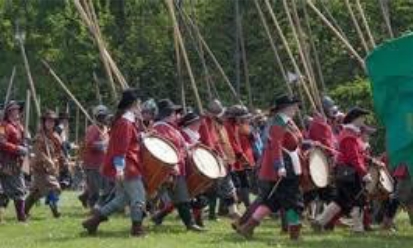
About 10 miles away from Southam, in the pretty village of Radway, near Edgehill, there is now a permanent exhibition about the Battle of Edgehill, showing the types of weapons used, the clothes worn, and giving insights into the impact of the War and the Battle on the local populace. The display is located in St Peter’s Church which is open daily from dawn ‘til dusk. For more information visit this website: www.battleofedgehillexhibitionradway.org.uk
Spring 2016 Exhibition: “Keep the Home Fires burning”
Our new exhibition, scheduled to open on 5th January 2016, takes its title from the popular 1914 Ivor Novello song. The exhibition aims to show how the families of soldiers lived and coped with the separation from their loved ones, who were fighting in the battlefields of World War 1.
The exhibition curator, Val Brodie, is seeking additional domestic artefacts, clothes and memorabilia from this era and photographs showing how people lived on the home front as they waited anxiously for news of their menfolk. If you have anything suitable that you would be prepared to loan to us for this exhibition, please do get in touch with Val on 01926 812179, or call in to Vivian House for a chat any Tuesday morning between 10am and 12 noon.
An extract from The Shakespeare Birthplace Trust Website……
Illuminating Shakespeare Thursday, Friday and Saturday nights from 26 Nov – 19 Dec 2015 from 4.00pm – 6.00pm.
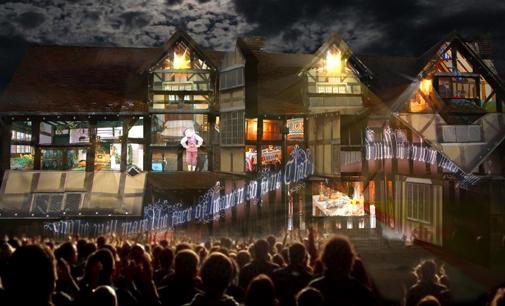
Get an immersive glimpse of Shakespeare’s early life with this winter’s all new light show, free to enjoy in Stratford-upon-Avon town centre. See through the walls of Shakespeare’s Birthplace as it morphs into a treasure trove of wonders, the very place that inspired Shakespeare’s wonderful words!
We invite you to take control and choose which room to explore, opening the Birthplace up like a doll’s house of delights. Witness young William finding words and moments that will shape his future writing. After the show, wander into the garden to experience magical interactive illuminations based on Shakespeare’s works. See fireflies dancing through the trees, silhouettes gracing the walls and letters tumbling down paths. Share your first memories of Shakespeare in a recording on our digital memory box, which will feature in a very special event to launch 2016.
Best of all, Illuminating Shakespeare is completely free to enjoy! So head to Henley Street from 4-6pm on Thursday, Friday and Saturday nights from 26 Nov – 19 Dec.
An Exhibition at the Ashmolean Museum in Broadway…..
Remembering the Great War 1914–1918
Exhibition closes on 17th January 2016
This exhibition showcases rarely seen prints, drawings and watercolours revealing the effects of war on soldiers and civilians through the eyes of contemporary artists.
Dramatic depictions of diving bombers, devastated landscapes and action in the trenches, contrasted with scenes of life on the Home Front, make this a moving and educational display.
The selection includes work by Augustus John, Frank Brangwyn, Eric Kennington and Christopher Nevision. The exhibition contrasts officially sanctioned propaganda with images produced independently.
An extract from the Newsletter of Chipping Campden History Society concerning one of their ongoing projects….. Campden’s Changing Landscape
How has Campden’s landscape changed over the centuries? How did our forebears farm the land and what effect did this have on land and buildings and the people themselves?
CCHS has a project group which is, for example, mapping “ridge and furrow” fields, the extent and effect of enclosures in general and the Campden Inclosure Act and Award in particular.
Workshop – What has been done and what to do in the future?
Ten CCHS members attended this workshop on 15th July 2013 and, together with our President, Professor Christopher Dyer, University of Leicester, we heard about the work that has been done so far by the project group and discussed what our priorities should be for the future with the expert guidance of Prof. Dyer.
Jill Wilson took us through a whistlestop tour of the geology of the area and how this affected the settlement. This neatly led us on to the origins of the introduction of sheep and the development of the wool industry and the effect this had on the landscape.
Ridge and Furrow – The main focus of work recently has been mapping the existence of ridge and furrow in the fields around Campden. This involves physically walking the fields and noting which still have visible ridge and furrow, but also studying aerial photographs taken just after the Second World War and held in the National Photographic Archive. This work continues.
Ilona Sekacz 12 November 2015
Newsletter September 2015
Next Meeting. A reminder that our new season of indoor meetings will start on Friday 18 September 2015 when Dr Ruth Barbour will be talking about Brailes: an eighteenth Catholic ‘Hotspot’ in Kineton Village Hall at 7.30pm.
Future Meetings
Friday 16 October 2015 The Sword in Medieval Europe presented by Clive Thomas
Friday 20 November 2015 Kineton’s soldiers from Bridge Street, during and after the First World War by David Fisher
Friday 11 December 2015 ‘Drive the Cold Winter Away’: seasonal music and stories from history and tradition from Richard and Elizabeth York
Other Societies
Lighthorne History Society
On Friday 11 September 2015 in Lighthorne Village Hall at 8.00pm, Dr Val Brodie will be talking about “Bandages and Fresh Air – Southam women in World War One”.
‘Bandages and Fresh Air’ traces the story of the Southam Red Cross Hospital and the women and girls who, as volunteers, cared for the wounded. It has been brought to life by the memories and stories of their descendants told to Val Brodie, and her talk is illustrated by a unique set of photographs from the Southam Heritage Collection.
With best wishes
Peter Ashley-Smith, K&DLHG secretary 1 September 2015
Newsletter June 2015
The next K&DLHG Summer Outing, organised by Isobel Gill email: Isobel.gill22@btinternet.com, is on Friday 17 July 2015. Evening visit to Edgehill Hub in Radway Church and village walk. Meet outside the church at 7.30pm. Refreshments will be provided. £5
Our indoor evening meetings resume on Friday 18 September 2015 when Dr Ruth Barbour will be talking about ‘Brailes: an eighteenth century Catholic ‘Hotspot.’
Kineton Railway Station. Chris Gibbons has alerted us to a great clip featuring Kineton station in a film ‘Last Train to Woodford Halse’ from the MACE archive. Whether or not you are into railway history, it is highly entertaining. Go to https://vimeo.com/46279896 and start at 13.53
Tithes, Taxes and Old Southam Town The Cardall Collection summer exhibition is based on the archaeological finds at Little Park opposite the church in Southam town and tells the story of how the town developed from Roman times until present day. Open from 2nd June to 29th September 2015.
Mornings 10am-12pm on Tuesdays and Fridays, on Farmers Market Saturdays, and all Saturdays during August. At Vivian House on Market Hill / Park Lane. For further information email: cardallcollection@hotmail.co.uk or tel: 01926 814214. Friday morning is also the only day of the week when St James’ church is open to the public outside weekend services.
With best wishes
Peter Ashley-Smith, K&DLHG secretary
21 June 2015
Summer events 2015
As Summer (?) approaches, many organisations are offering activities, both indoors and out, which may be of interest to K&DLHG members.
K&DLHG Summer Outings
At the head of the list are our own Summer Outings, organised by Isobel Gill, to whom all requests should now be made. Contact email: Isobel.gill22@btinternet.com. Please don’t leave booking to the last moment.
Friday 12 June 2015 [note change from programme card] Evening visit to Westcote Manor Farm, (home of David Freke and Ilona Sekacz), Edgehill, OX15 6HS. Meet at the farm, on the site of a deserted medieval village, at 7.00pm. Refreshments will be provided. £2-50.
Friday 17 July 2015 Evening visit to Edgehill Hub in Radway Church and village walk. Meet outside the church at 7.30pm. Refreshments will be provided. £5
Saturday 8 August 2015 Afternoon visit to Selly Manor, Birmingham, B30 2AE. Tour starts at 2.00pm at Selly Manor. Own transport. Several suggestions to make a full day outing – further details from Isobel £8
ooooooo
Warwickshire Local History Society celebrates Fifty Years
The WLHS invites you to our 50thBirthday Party
Saturday 19 September 2015, 10:00am to 4:30pm
Tickets: £35 each (see booking form at bottom of this page).
Join us at Stoneleigh Abbey to celebrate our first fifty years with outstanding speakers, a Tour of the Abbey, Coffee, Lunch and Birthday Tea
Headline Speakers
John Beckett Professor of Regional History, University of Nottingham
Christopher Dyer Emeritus Professor of History, University of Leicester
Michael Wood TV historian, Professor in Public History, University of Manchester
Afternoon Entertainment:
Lesley Smith as Queen Elizabeth I
ooooooo
Warwick Words Events
1. A talk from two historians about the Great War diary of Frederick Kelly. He was a musician, composer and Olympic rower who was killed in the First World War.
On Friday 22nd May 2015
At 2.00 pm
In Lord Leycester hospital
Price £10 (includes tea and cake)
Tickets available at the door or through the box office
For more details go to www.warwickwords.co.uk and click on What’s On and then Kelly’s War.
2. A talk by Matthew Engel on the curious customs of our English counties
On Friday 5th June 2015
At 7.30 pm
In Lord Leycester Hospital Hospital
Price £12 (£10 concessions)
Tickets available at the door or through the box office
For more details go to www.warwickwords.co.uk and click on What’s On and then Engel’s England
ooooooo
Our indoor evening meetings resume on Friday 18 September 2015 when Dr Ruth Barbour will be talking about ‘Brailes: an eighteenth century Catholic ‘Hotspot.’
With best wishes
Peter Ashley-Smith, K&DLHG secretary
20 May 2015
————————————————————————————————-
Booking Form for WLHS 50th Birthday Party
In order that we can let you know if your booking has been successful, a method of
contact is essential. Please ensure you have included an email address, telephone contact
or a stamped addressed envelope(when sending the booking form and payment).
All tickets are priced at £35 each; cheques should be made payable to ‘Warwickshire
Local History Society’ and sent to:
Neville Usher, 6, The Fold, Payton Street, Stratford upon Avon, CV37 6NJ.
Saturday 19 September 2015, 50th Anniversary Party
Name …………………………………………………………………………………………………………………
Address ………………………………………………………………………………………………………………
………………………………………………………………………………………………………………………….
………………………………………………………………………………………………………………………….
Telephone number……………………………………………………………………………………………….
Email address………………………………………………………………………………………………………………………
Number of tickets required ………….@ £35 each, total £ …………………
Registered charity no: 511528
Southam Heritage Collection Spring/Summer newsletter 2015
Newsletter May 2015
Next meeting A reminder that our next meeting, the last indoor meeting before the Summer Outings, is on Friday 15 May 2015. Elizabeth Allison will be talking about ‘Follies: a look at some eccentric buildings.’
Summer Outings. There will be another opportunity to buy tickets for the three outings organised for us by Isobel Gill:
Friday 12 June 2015. [note change from programme card] Evening visit to Westcote Manor Farm, Edgehill, OX15 6HS. Meet at the farm, on the site of a deserted medieval village, at 7.00pm. Refreshments will be provided. £2-50.
Friday 17 July 2015. Evening visit to Edgehill Hub in Radway Church and village walk. Meet outside the church at 7.30pm. Refreshments will be provided. £5
Saturday 8 August 2015. Afternoon visit to Selly Manor, Birmingham, B30 2AE. Tour starts at 2.00pm at Selly Manor. Own transport. Several suggestions to make a full day outing – further details from Isobel email: Isobel.gill22@btinternet.com £8
Saturday 9 and Sunday 10 May 2015. Brian Lewis will be opening the Windmill at the top of Pittern Hill for public viewing between 2.00pm and 5.00pm on both days.
Friday 19- Sunday 21 June 2015. Leamington Looks Back at Waterloo
A weekend of activities to commemorate the Bicentenary of the Battle of Waterloo 1815 – 2015
Rattle in a Red Coat, Art Gallery, Fri 19 June, 1pm – 1.30pm. Free Friday Focus Talk.
Discover more about the Napoleonic Wars.
Regency Revel, Pump Rooms, Fri 19 June, 7.30pm – 11pm.
Music, dancing, readings from Jane Austen and games [tickets £25 to include a drink & canapés]
Music, Medals and the Military, Art Gallery & Museum and Pump Room Gardens, Sat 20 June 12pm – 4pm. Free drop-in activities.
Meet ‘The Duke of Wellington’ and find out how he won the Battle of Waterloo.
Listen to live Regency music and make a military hat or marvellous medal
Handsome Hats, Art Gallery, Sun 21 June 11am – 4pm. Free drop-in activity.
Make and decorate a hat suitable for a Regency lady or gentleman
Over the Waterloo Weekend there will be an opportunity to see objects relating to the Napoleonic Wars from the Art Gallery & Museum collection.
With best wishes
Peter Ashley-Smith, K&DLHG secretary
5 May 2015
Newsletter April 2015
Jill Brazil. I am sure that members will be sad to hear that Jill Brazil died on 29 March 2015. As many of you will know, Jill has been receiving treatments for cancer for several years, and that she had periods of remission during which it was hoped that the treatments had been successful.
Jill was co-opted to the committee of the Kineton and District LHG in 1998, was elected vice-chairman in 2001, soon taking over as chairman for the next three years. She stepped down from the committee in 2007, but continued as an active and supportive member of the Group. We last saw her recently at this year’s AGM and Supper.
Jill’s funeral is to be held at Oakley Wood Crematorium on Tuesday 21 April 2015 at 12 noon. This will be followed by a gathering at the Kineton Sports and Social Club. To assist with the planning of the catering arrangements, it will be helpful you can let Pat Randle know (Beech Lawn, Mill Lane, Kineton; 01926-640078; email: mac.randle@kineton.co.uk) as soon as possible if it is likely that you will be going on to the KS&SC.
Second World War. On a lighter note, we have been invited to view a small exhibition about WW2, prepared by the son of Sheena Harrison. He is educated at home and it would be nice if some of us could support his history work. The exhibition is at Sheena’s house, 6 Verney Houses, Little Kineton, on Wednesday 15 April – all day. Just turn up, or phone Sheena (01926 691129) for further details.
Next meeting. A reminder that, on Friday 17 April 2015 at 7.30pm, Chris Rice will be talking about The Landscape of Compton Verney.
Subscriptions. For those of you who have not already re-joined, annual subscriptions (still £7-50 per person) are now due and can be paid at the April meeting. The Group’s programme card for 2015-16 is now available.
Outings 2015. Further details of the three summer outing will be included in the next newsletter in early April, and bookings can be made at the meetings in April and May.
With best wishes
Peter Ashley-Smith,Secretary
9 April 2015
